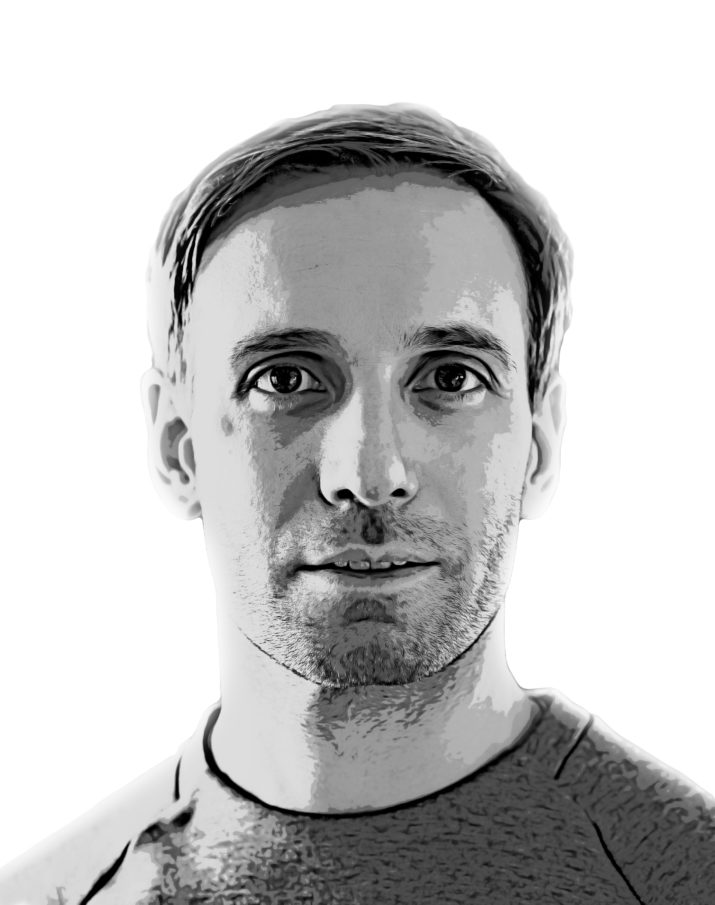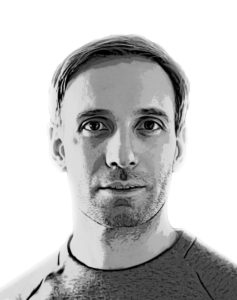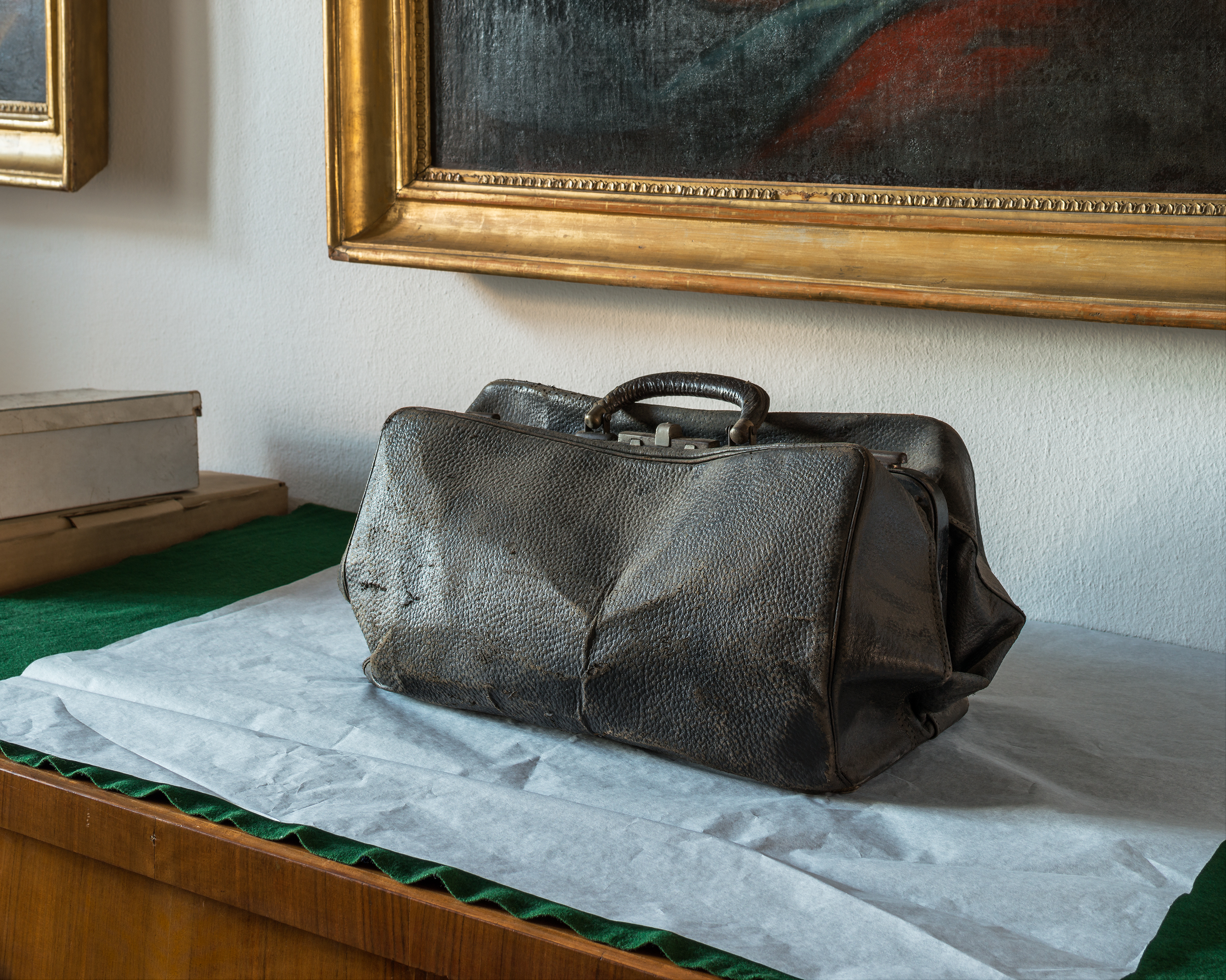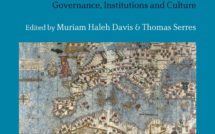

It was a sunny, early autumn morning in Budapest when I met Minneapolis-based artist Anthony Marchetti, where he had come as Fulbright Scholar to Hungary (2016-2017) to lecture and to complete his most recent project, Paul. An artistic endeavor with personal overtones, Marchetti’s journey from the United States to Hungary was a mirror image of his subject: Paul is a collection of photographs that relate to his maternal grandmother’s refugee journey from Hungary to the United States at the end of World War II. As in much of his earlier work, Marchetti’s latest project includes landscapes, locations, and artifacts that indirectly circumscribe the absence of the eponymous Paul.
Today, Marchetti is a 2018 Minnesota State Arts Board Artist Initiative Grant recipient (an award he also received in 2016, 2012, and 2010), and two-time McKnight Photography Fellow (2013, 2007). He is also a full-time faculty member in Photography, New Media, and Art History in the Minnesota State Colleges and Universities system. His Hungary-based Paul was recently exhibited at Bethel University’s Johnson Gallery, with select images featured as part of Extraordinary Outdoors at the Nemeth Art Center.
For me, Marchetti’s photographs are enhanced through our conversations and by his reflections on and approach to photography. For him, photography blurs the boundary between fact and fiction, evidence and meaning, and—as in Paul—can fill the broken narratives of our fragmented pasts. I have the chance to share Marchetti’s insights with readers of EuropeNow after catching up with him just after the closing of the first exhibition of Paul. Here, I discuss with Marchetti his take on the development of Paul as a visiting photographer (with local roots) in Hungary; our conversation is complemented by a selection of images from this project, more of which can be found on his website.
—June Brawner for EuropeNow
EuropeNow First, can you tell me a little bit about Paul and how you came to this project?
Anthony Marchetti Paul started from questions I had about my family’s history following WWII and their eventual emigration to the United States. In 1945, my maternal grandmother and her family fled Hungary as Russian armies advanced from the east. They traveled through Austria to Germany, eventually settling in a displaced-persons camp in Munich. There, my grandmother met and became engaged to a Hungarian man named Paul. When sponsorship to the U.S. opened, my grandmother left with her family, certain her fiancé would follow. During transatlantic passage, my grandmother was ill with symptoms of early pregnancy, ultimately leading to my mother’s birth. My grandmother’s fiancé never came to America nor did they meet again.
My grandmother has offered brief glimpses into her life as a child in Hungary, but she rarely speaks about her time as a refugee at the end of WWII, and even less about her fiancé. My grandmother is reticent because recounting her experiences during and after the war means reliving them. Feeling ashamed, she refuses to speak about Paul’s inability or failure to follow her and her subsequent pregnancy. I began the Paul project by making photographs relating to pieces of the story she was willing to share. From that point forward, I used photography to create what was still missing. This work is an attempt to visualize and reconstruct a past and a world that no longer exists except in relatively few place markers, carried objects, and memories.

Grandma | 2015
EuropeNow Unlike your earlier work, many of the images in Paul are portraits. Who are these people?
Anthony Marchetti I started this project by working with the few remaining photographs of Paul made shortly before my grandmother and her family left Europe for America. These provided actual evidence of this man, the missing person in my family’s narrative. I combined these family snapshots into a single piece titled Every Paul, presenting an accumulation of all visual evidence we still have of this man. These photographs, viewed individually or as an aggregate, don’t really bring us much closer to knowing him. Instead, the composite image is more of a statement about the limitations of photography. Although photographs can serve as evidentiary documents, they often fail to reveal the meaning we seek.
During my Fulbright, I made several portraits of Hungarian men who would be Paul’s age if he were still alive. These men serve as visual replacements or stand-ins for the missing character in this narrative. In the series, there are several such portraits, all with the title ‘Paul.’ Each of these men, or all of them together, serve as my grandfather, Paul, for the retelling of this story.
Every Paul | 2015
EuropeNow A common theme connecting Paul to your previous projects is homes—not always as stationary anchors, but as spaces of transience or in-transit (Apartment for Rent, Occidente Nuevo). In Paul, homes appear again—in villages, high-rise blocks, or just off a worn path—but in a less-foregrounded way. What is the significance of these structures in Paul? Are they a continuation of earlier themes in your work, or do these homes represent something different?
Anthony Marchetti As a photographer, I’ve always been interested in how humans use and interact with their built environments. In the Apartment for Rent series, I photographed recently vacated American suburban apartments, focusing on the detritus left behind by former tenants. Rooms became containers for evidence: each mark on the wall, imprint on the carpet, and abandoned object offered a glimpse into private lives of previous renters. The Occidente Nuevo project documented results of cross-border transmigration of building materials and small suburban homes from San Diego to Tijuana, where these structures were refashioned into vibrant living and workspaces. In these earlier projects, I considered myself more of a documentary photographer, using the medium to present evidence to the viewer about a topic or subject matter. These two earlier projects used a serial format, each image an example, one in a list of facts. The resulting work was cohesive, but also formulaic and less narratively interesting.
The structures in Paul serve as context for this story. For example, images of abandoned Russian military structures imply the advancing armies and subsequent occupation that forced my grandmother and her family from their home. Several photographs of Hungarian houses in the series are all titled ‘Grandma’s House’ and, like the repetition of the ‘Paul’ portraits, serve as stand-ins for my grandmother’s actual home in Szeged. This calls into question both limitations of memory, and the veracity of photography in this series. By presenting several options for elements of this narrative, viewers learn that I am creating narrative as opposed to a strictly retelling a factual family story. Each of these houses could be my grandmother’s home, or perhaps none of them are.
The method used to photograph structures in Paul also differed significantly from previous projects. In earlier work, the interiors of apartments or exteriors of Tijuana homes, were shown in a more straightforward way. Evidence was presented more objectively, allowing the viewer to draw his or her own conclusions. In the Paul project, the buildings are often hidden or obscured by the landscape. Although I didn’t consciously set out to make photographs this way, I soon noticed that I kept returning to this visual device. It appears that each photograph offers, at best, only partial evidence, and I became willing to offer only small glimpses of this subject matter.

Grandma’s House | 2018

Soviet Factory | 2018
EuropeNow You’ve said that your images are meant to offer “evidentiary clues” (Exposure, 2009) through the traces of lived lives, where “the photographic medium has had a varied and progressively troubled relationship with fact” (American Period Rooms: Inside/Out, 2016). How is your use of photography in Paul related to this stance and the fragile relationship between fact and fiction?
Anthony Marchetti I began my photographic career believing in the power of photography to present a story in a factual way, as evidenced in my first two projects. But that approach is also limited, especially when working with a narrative like this Paul project. If the facts no longer exist, I must rely on other methods to make meaning in the work. The photographs are wholly ‘real’ as seen by the camera and therefore have a direct relationship to fact and truth, but they also become fictive in the reconstruction of my family’s story. By including multiple ‘Paul’ portraits or a series of images that all represent my grandmother’s house, I’m calling attention to photography’s tenuous link with truth. And by relying on the narrative between the few facts that do remain from my grandmother’s story, I hope to create a more universal story rather than a simple retelling of one family’s history following WWII.
EuropeNow How has your closeness to the subject influenced your artistic approach?
Anthony Marchetti When I first started the project, I was drawn to known facts about my family’s story. I initially felt that any variance from the actual story was a betrayal of what my grandmother experienced. As I continued this work and learned that so many of the details were missing, I slowly allowed myself to fill in the gaps with photographs that represented pieces of the narrative. Once that process unfolded, I saw that my family’s story was merely a starting point for a narrative that I could construct. The further I moved from my attempts to recreate actual pieces of the story, the more interested I became in the work. This is still a deeply personal project, but it has moved beyond a simple retelling of my family’s story.
EuropeNow Do you have a favorite image from this series?
Anthony Marchetti My favorite images are the portraits of elderly Hungarian men. Nearly all my previous work consisted of landscapes, cityscapes, or other studies of architecture. The portraits represent both a conceptual and technical step forward for me as a photographer. Also, photographers experience special connections to images based on the working process behind their creation. One of my images in the series is of an elderly man viewed in profile against a white curtain. This was the only man I photographed alone. Normally, I had assistants who served as interpreters and collaborators on a shoot. I remember riding the bus to the man’s apartment and feeling nervous to be alone without my usual collaborators. I talked with the man and his daughter, learned about their lives, and attempted to tell them about my project. About a year and a half later, his daughter wrote to inform me that her father had passed away, and to inquire if it would be appropriate to use my portrait of her father for his funeral. I was honored and touched. I never thought that this portrait would serve multiple roles, that it could be so meaningful to the man’s family and so important to my project and the recreation of my family’s narrative.

Paul | 2017

Paul | 2018
EuropeNow This project was obviously inspired by your own family history and the mythology of a grandfather you never met. In a more pragmatic sense, did your artistic approach or methodology also draw inspiration from the region? Are there any Hungarian or Central European artists or trends that inspired you?
Anthony Marchetti The region was vital to the success of this project. The Russians occupied Hungary until 1989, and only in fits and starts has it modernized like large parts of western Europe. In some sense, the landscape of Hungary feels untouched, like it belongs to another era. There are many markers in my photographs that speak to current time, and yet there seems to be a patina covering Hungary, especially in the countryside, that relates to a previous time. Also, the light is simply beautiful, especially in the fall and winter months, leading to pale blue and purple skies. There’s so much moisture in the air across the plains of Hungary during these colder months that horizons and distant details are often swallowed by fog, and a soft light evenly illuminates subjects.

Zirc | 2015
EuropeNow Was there an element of being immersed in Hungary that played a role in the outcome?
Anthony Marchetti Prior to my Fulbright year, I made four trips to the region to work on the project, but I remained an outsider. My initial images were more topographical, and I was merely scratching the surface of what the region had to offer. During my Fulbright, I taught at the Laszlo-Moholy Nagy University of Art and Design (MOME) in Budapest and worked closely with the photography faculty. I hired several MOME students as photographic assistants to assist me with research and on-site shoots. And a fellow Fulbrighter, Aki Neumann, was instrumental in the work created in Hungary, helping me to make photographs and to determine meaning through the editing process. These relationships helped shape my work during the Fulbright year and the progress I made with this series would never have occurred without their guidance and collaboration.
EuropeNow You worked as a visiting professor at the Laszlo-Moholy Nagy University of Art and Design in Budapest as a Fulbright Award recipient, just as controversy around proposed amendments in Hungarian higher education began to escalate. From one perspective, this controversy mirrors broader discussions about Hungary’s position in the European Union and a historically couched notion of Hungarian autonomy and identity. Was this political context influential in the making of Paul or your experience as an instructor? Is there anything that Paul aims to say regarding current social or political issues?
Anthony Marchetti Although this project started from personal reflection about a family narrative, it has moved to a more universal exploration of emigration. And although my family’s story happened decades ago, it is my hope that viewers will find connection to current social and political issues surrounding today’s immigration. I’m hesitant to align this project too closely to more political work exploring current migration crises across the region. Projects like Ad van Denderen’s Go No Go, Thomas Mailander’s Cathedral Cars, Guillermo Avril’s and Carlos Spottorno’s The Crack, or Richard Moss’s Incoming expertly deal with migration across and through Europe over the last decade. My project does not fit with these more current explorations of this important topic, but I believe it can add to the conversation of human migration. It is my hope that the work can elevate personal history to universal narrative: the effects of war, leaving home, crossing borders, and keeping one’s culture while beginning anew.

Paul’s Coat | 2017

Paul’s Dental Bag | 2017
EuropeNow You were recently awarded a 2018 Minnesota State Arts Board Artist Initiative Grant to complete Paul, which just featured in its first exhibition. What’s next for you?
Anthony Marchetti The first solo exhibition of Paul was, for me, a significant event. It represented over five years of focused work on this project. However, a single exhibition is limited in scale and scope as only a small selection of images can be included in any gallery. I hung twenty-one photographs for this first exhibition, a fairly large number. Yet, so many images exist as part of this project, from those exploring similar themes presented in the Bethel exhibition, to others that move the project in slightly new directions. So, I will continue to seek out exhibition opportunities. I will visit Budapest in early 2019 to garner support for an exhibition there, but I believe ultimately, the work would be best served in a substantive monograph.
EuropeNow Are there any underappreciated or emerging Hungarian (or Hungarian-American) artists you think people should know about?
Anthony Marchetti I’m excited to watch the students I worked with at MOME as they continue their education and exploration of the photographic medium. I was also inspired by the faculty members at MOME – Gábor Arion Kudász, Fátyol Viola, and Máté Gábor are excellent and tireless practitioners of the photographic medium.
Anthony Marchetti completed a BA at Gustavus Adolphus College and an MFA at the University of Minnesota. Currently, he is a full-time faculty member at Anoka-‐Ramsey Community College. A four-‐time Minnesota State Arts Board recipient, two-‐time Bush Fellowship finalist, and a McKnight fellow in 2007 and 2013, his work has been exhibited regionally and nationally, including: the Frederick R. Weisman Art Museum; Minnesota Museum of American Art; Rochester Center for the Arts; Vermont Center for Photography; Momenta Art, Brooklyn, New York; the Rayko Photo Center, San Francisco; and Casa del Tunel, Tijuana, Mexico. His work is in the permanent collection of the Weisman Art Museum, the Minneapolis Institute of Art, Gustavus Adolphus College, and the Hungarian Multicultural Center. In 2016, Marchetti was a Fulbright Scholar in Budapest, Hungary, where he taught at the Moholy-‐Nagy University of Art and Design and continued work on his current project that explores his maternal grandmother’s flight from Europe following World War II.
June Brawner is a 2018-2019 Mellon-Council for European Studies Dissertation Completion Fellow and previously a Fulbright Study Award recipient (Hungary, 2016-2017). She is a doctoral candidate in anthropology at the University of Georgia and holds degrees in sociology, anthropology, crop and soil science, and music.
Published on February 5, 2018.




